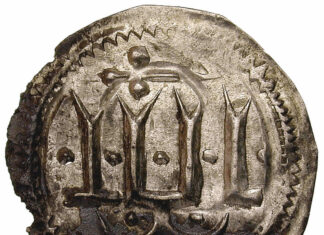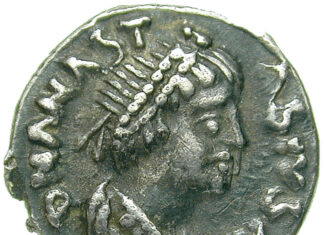Easy
Numismatic Puzzle: Sixtus V
The Vatican’s finances were in a bad way in the 16th century. As the new pope, Sixtus V – here depicted on a 1588 silver coin – therefore relied on high taxes and rigorous saving. After a pontificate of only five years, he died as one of the richest rulers in Europe.
Numismatic Puzzle: Manilla
A manilla looks like a bangle, but its opening is too wide to be used as jewellery. In fact, Manillas were used for centuries as a currency by Europeans to trade with West African nations.
Numismatic Puzzle: Melanesian Boar’s Tusk
This is a boar’s tusk. On a group of islands east of Australia, wealth is traditionally quantified using pigs as a unit of measurement. Circular boar’s tusks are still used as bride price or atonement money – and they even adorn the national flag of Vanuatu.
Numismatic Puzzle: Niccolò Tron
The doge was the highest official of Venice – and lost more and more of his power as time went on. In the 1470s, Niccolò Tron became the only doge to be portraited on a coin, the Lira Tron, which was named after him.
Numismatic Puzzle: The Noble
In 1340, England’s King Edward III defeated France in a sea battle – the beginning of the Hundred Years’ War. He celebrated this victory in 1344 with a new gold coin, the noble. For centuries, the noble was an extremely popular coin on the continent, too.
Numismatic Puzzle: Matapan
Matapan is the Arabic term for the enthroned Christ on the reverse of a heavy Venetian silver coin introduced around 1200. Today, however, you will put together the obverses’ motif: St Mark who presents the banner to the head of state.
Numismatic Puzzle: Harald Bluetooth
In the 10th century, Harald Bluetooth introduced a standardized coinage system in Denmark. His half-bracteates were wafer-thin, which is why the motif struck on the obverse could also be seen on the reverse.
Numismatic Puzzle: Anastasius
This time we have a so-called half siliqua of Theodoric the Great, King of the Ostrogoths. He ruled over Italy from AD 493 to 526, with the favour of the powerful Eastern Roman Emperor Anastasius I. That’s why we see the portrait of Anastasius on the obverse.
Numismatic Puzzle: A New Capital for the Roman People
Today’s puzzle shows us how the Roman Empire moved its centre of power around 300: on this solidus, Roma presents the globe to Emperor Constantine the Great. From then on, it was no longer the old lady on the Tiber who played first fiddle but the metropolis on the Bosporus.
Numismatic Puzzle: Kushan the Sasanidian Way
This gold coin comes from the Empire of Kushan in Northern India. But it resembles Sasanian coins because – when it was struck in the middle of the 4th c. AD – the Sasanians had conquered the Kushan empire at that time.












